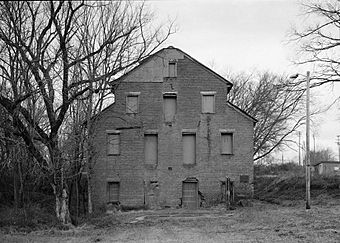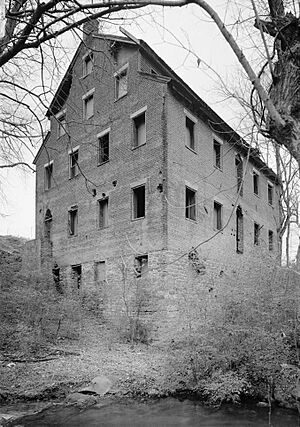Lenoir Cotton Mill facts for kids
|
Lenoir Cotton Mill
|
|
|
Formerly listed on the U.S. National Register of Historic Places
|
|

Lenoir Cotton Mill in 1983
|
|
| Location | Depot Street in Lenoir City, Tennessee |
|---|---|
| Built | circa 1830 |
| NRHP reference No. | 75001767 |
Quick facts for kids Significant dates |
|
| Added to NRHP | 1973 |
| Removed from NRHP | July 30, 2002 |
The Lenoir Cotton Mill was an old factory from the 1800s. It was located in Lenoir City, Tennessee, in the United States. This mill was one of the first industrial buildings in Tennessee. It made cotton products from about 1830 until the 1950s.
The mill was recognized for its history in the 1970s. It was added to the National Register of Historic Places. People tried to fix up the mill starting in 1980. Sadly, someone burned it down in 1991 before the repairs were finished.
The Lenoir Cotton Mill was part of a big business started by William Ballard Lenoir (1775–1852). He was an early settler and a businessman. William Ballard Lenoir moved to the area in 1810. His father, General William Lenoir, gave him a large piece of land. This land is now Lenoir City.
The younger Lenoir started the Lenoir Manufacturing Company in 1817. This company did many things, like farming and manufacturing. The cotton mill was finished in the early 1830s. It grew bigger over the years. During the American Civil War, Union soldiers destroyed parts of the Lenoir family's property. The family supported the Confederacy. However, the soldiers did not burn the mill. This was because William Ballard Lenoir's son, Benjamin, was a Mason. After the Lenoir family sold the mill in the 1890s, it became a hosiery mill (making socks). Later, it was used as a flour mill.
Where the Mill Was Located
The Lenoir Cotton Mill site is in downtown Lenoir City. It is near Depot Street and South Hill Street. This spot is also close to U.S. Route 11. A small stream called Town Creek flows along the east side of the mill site. This creek flows into the Tennessee River about half a mile south.
The house of William Ballard Lenoir, built in 1821, is still there. It is across the street from where the mill stood. However, it has been changed a lot and is now an apartment building. Another building connected to the mill is the Lenoir Cotton Mill Warehouse. It is about half a mile to the southeast. This warehouse has been fixed up and is now a home.
The Mill's History
The land that became Lenoir City was first given to General William Lenoir (1751–1839). He received the 5,000-acre (2,000 ha) of land for his service in the American Revolutionary War. General Lenoir then gave the land to his son, William Ballard Lenoir. William Ballard Lenoir and his family moved there in 1810.
In 1817, William Ballard Lenoir started the Lenoir Manufacturing Company. He worked on many different farming and industrial projects. Besides the cotton mill, Lenoir also built a sawmill and a gristmill on Town Creek. He also raised farm animals. The Lenoir family used both enslaved people and paid workers for their businesses.
The cotton mill was finished in the early 1830s. A mill builder from Pittsburgh named E.F. Faber helped build it. In 1831, he made a spinning machine with 113 spindles and three looms for the mill. Lenoir's farm grew its own cotton in the 1830s. They also used a cotton gin to prepare it. Later, Lenoir's sons bought raw cotton for the mill.
By the mid-1850s, the mill had 620 spindles. It was powered by an overshot waterwheel. This type of waterwheel uses water flowing over the top to make it spin. In 1855, the mill was worth $12,000. This made it the most valuable thing the Lenoir family owned.
After William Ballard Lenoir died in 1852, his sons kept the mill running. During the Civil War (1861–1865), the Lenoir family supported the Confederacy. In 1863, Union soldiers took over the Lenoir property. They burned the family's train station, general store, and other buildings. As they were about to burn the cotton mill, William Ballard Lenoir's son, Benjamin Ballard Lenoir, showed a secret Masonic sign to the Union troops. Because of this, the soldiers did not burn the mill.
By 1890, the Lenoir City Company bought the Lenoir property. The mill had grown to have over 1,000 spindles. In the 1890s, the Holston Manufacturing Company used the mill to make hosiery. Later, the mill was changed into a flour mill. It operated until the 1950s.
In 1980, a group called the Lenoir Cotton Mill Association was formed. They wanted to save the mill. They raised over $100,000 to fix it up. However, the mill was destroyed by arson in 1991. Arson means it was deliberately set on fire. In 1996, Lenoir City decided not to rebuild the mill. Instead, they made the mill's ruins part of a city park. One of the mill's old warehouses, the Lenoir Cotton Mill Warehouse, was restored. It was added to the National Register of Historic Places in 2006.
Images for kids






